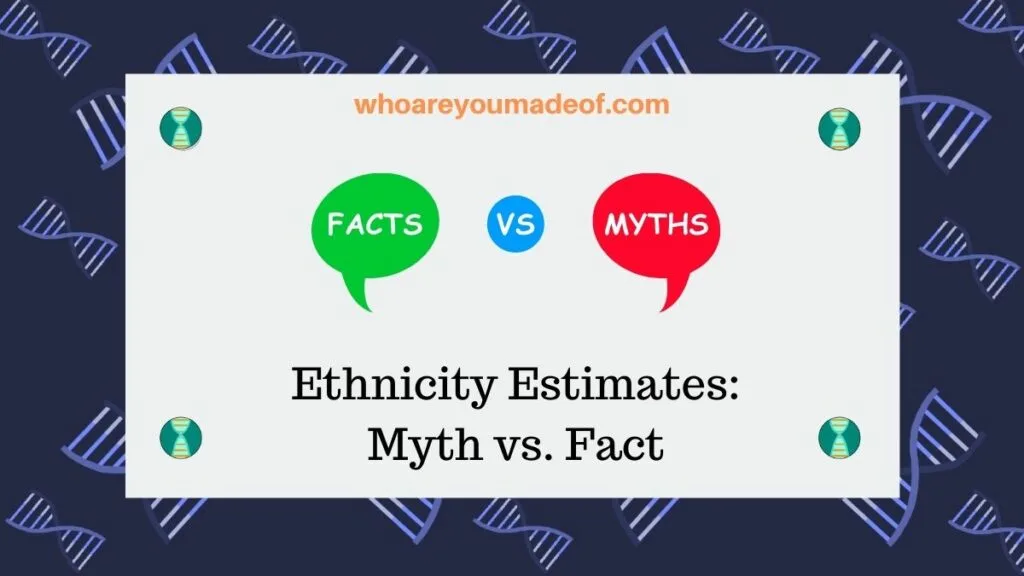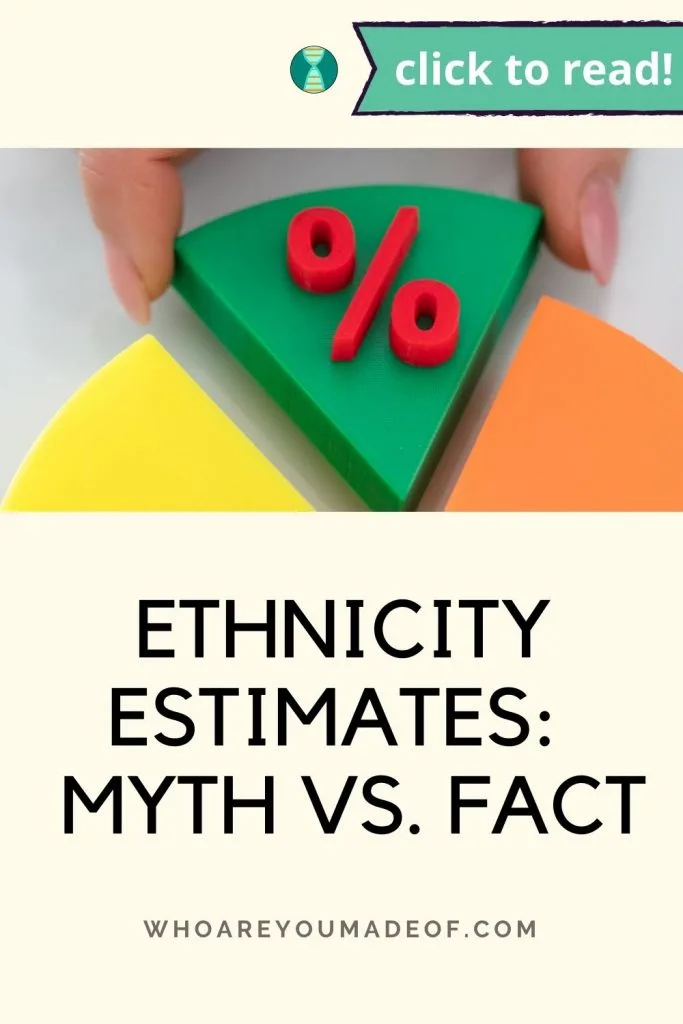Ethnicity estimates are the most popular feature of DNA tests, yet also the most misunderstood. Here, you will learn the truth about a few of the top myths about ethnicity estimates.
The increased popularity of DNA testing has inspired people who don't really know very much about the topic to chime in with their own opinion about the estimates, which are sometimes also known as ancestry composition reports or myOrigins estimates.
Don't worry, though, because you have come to the right place to get the facts.

Most of the journalists who have written articles for major news outlets about ethnicity estimates have never even taken a DNA test. Most of those journalists who have tested their DNA have never seriously used their DNA results to extensively explore their family history.
Even fewer have extensive experience with genealogy.
It's as the old adage always goes: When you are evaluating the accuracy of a particular bit of information, it is crucial to consider the source, and what the source would like to have you believe. Sensational journalism gets our attention, and gets clicks, too.
What you'll find below is a more balanced view on the accuracy, helpfulness, and relevance of the infamous "ethnicity estimate".
Myth #1 Ethnicity estimates aren't accurate
One of the most common myths surrounding ethnicity estimates is that they aren't accurate. In fact, it is common for people to suggest that it isn't possible for science to tell us where our ancestors may have lived simply based on our DNA.
Some people question the intentions of the DNA testing companies. For example, it's popular to claim that the ethnicity estimate is just a clever marketing ploy by DNA testing companies in order to sell more DNA testing kits.
Others posit that while companies are legitimately trying to provide accurate estimates, they just can't do it. A smaller minority of people believe that ethnicity estimates are a small part of some intricate conspiracy, the goal of which is unclear.
Fact: Ethnicity estimates are fairly accurate
In my extensive experience, ethnicity estimates are generally accurate and can provide helpful insight into where our families might have lived over the past few hundred years.
While it's true that each person shares 99.9% of their DNA with every other human, and we are almost completely genetically identical to each other in a grand sense, we aren't exactly alike.
In other words, we are really, really alike. But we are not identical.
Scientists are able to use the very small, statistically insignificant amount of DNA that we don't share in order to figure out where our families might have lived. It's hard to do, and the science behind the technology is still improving, but to say that it is impossible is untruthful.
Ethnicity estimates are most accurate in a very general sense, meaning that if you don't find Native American DNA in your results and instead found out that you are 100% European, there is an exceptionally high probability that you have no Native American DNA.
(Read that carefully: You might have no Native American DNA, but this is different than having no Native American ancestors - see Myth #2)
The generally accepted rule of thumb is that these tests are essentially 100% accurate at the continent level, except for percentages under 1%. Very small percentages, or "trace" amounts of a region might be accurate, but there is also a possibility that this is statistical noise.
Additionally, I have found that ethnicity estimates are also fairly accurate, especially with Ancestry DNA and 23andMe, at a region-by-region level. Most of the time when people spot an ethnicity region that doesn't make sense to them, there is usually another explanation other than "it's not accurate."
Myth #2 Ethnicity estimates should match your family tree
The second most popular "myth" around the ancestry estimate is the belief that the estimate should exactly match one's family tree.
For example, if I know that I have one grandparent from Sweden, one grandparent from Nigeria, the other from Mexico, and the other from England, I might expect to see something like this on my results:
- 25% Sweden
- 25% Nigeria
- 25% Mexico
- 25% England
Is this what I would see? Most definitely not! It's a myth that our ethnicity estimate will match our family trees.
(Plus, people are often surprised to find out that there is really no such thing as "Mexican" or "American" DNA.)
This "myth" is the cause of the majority of incorrect information circulating about ethnicity estimates. A person who knows a lot about their family history might take a DNA test and notice that the results don't seem to line up with what they know about their family tree.
This leads them to draw the conclusion that the ethnicity estimate is not accurate.
Fact: Ethnicity estimates rarely match a family tree perfectly
Our ethnicity estimates will rarely match our family trees in in the way that we might expect.
Aha! You might be thinking that you have gotten me to admit something shocking about the truth behind ethnicity estimates.
It's not so, however. In fact, this "truth" that we have discovered is all about how DNA is inherited.
Why is that?
We don't inherit 100% of either of our parent's DNA. In fact, we only inherit 50% of our mother's DNA and 50% of our father's DNA. Our parents didn't inherit 100% of their parent's DNA either, and just like with us, about 50% of each parent's DNA was "left behind" and not passed down.
If you consider that the same thing happens every generation, this means that there is an incredible amount of information about your family's full ancestry that is just lost to history.
When we take a DNA test, they are only able to perform their test on the DNA that we did inherit from our parents, grandparents, great-grandparents, great-great grandparents, etc. The DNA that they didn't pass down to us cannot be analyzed, of course.
So, when I get an e-mail from someone who is really angry about the fact that their ethnicity result showed no Italian DNA when they know for sure that their great-great grandmother was actually born in Italy, I know just what happened.
Myth #5 An ancestor born somewhere is "100%" from that region
Many people believe that their ancestor who was born in a region must have had "100%" of their DNA from that area. For example, we might expect an ancestor born in Italy would have been 100% Italian and an ancestor born in Estonia would have had 100% Baltic DNA.
If I have six great-great grandparents who were born in Germany, does that mean I should show 37.5% Germanic Europe DNA on my DNA results?
I certainly could show this amount of DNA from that region, but to be truthful, it's unlikely that I would. Why?
Fact: Your ancestor might have had DNA from a few different regions, and thus was not "100%" any particular region
You already know that I didn't inherit DNA equally from all of my ancestors because each generation 50% of DNA isn't passed down, but there is also one more important consideration to consider: My German ancestors might not have been 100% German.
They might have had Eastern European DNA, or DNA from France, or Denmark, or any other nearby, or even not nearby region.
Our ancestors were more mobile than we tend to think that they were, despite the how difficult it was to travel long distances. This means that they were also more "admixed" than we might imagine, sharing DNA with regions other than the ones where they lived.

Conclusion
I hope that this post has helped you understand some of the myths behind ethnicity estimates, and what the real facts are. If you have any questions about something that I mentioned in this post, or if you would like to talk about your own ethnicity estimate, I would love to hear from you in the discussion below.
Thanks for stopping by!

Floyd Staats
Friday 2nd of February 2024
Hi I've read that 1 percent Dna could be noise or could be real.If it is noise why would it be labeled a certain Ethnicity.
Barbara Spence
Saturday 16th of April 2022
I really enjoy your informative articles, Mercedes. Thank you! Hope you can shed some light on this. I'm confused by the updated DNA ethnicity results I just received from Ancestry. My former ethnicity region Ireland disappeared entirely in this year's update. A year ago Ireland was listed as 9% for me, and this year it is zero. Same thing happened with my son's results. I believe prior to 2021 that my Ireland results were higher than 9%. Also, it seems Ancestry has disabled the ability to review prior year's results. Can you help me understand this?
Mercedes
Sunday 17th of April 2022
I have seen the Ireland region appear and disappear for the kits I manage more than once, so I can really relate to the confusion. Our results can and should change over time, and they should become more accurate, in general. However, when it comes to regions that are very, very close in geographic distance and genetic heritage, it is difficult to distinguish between two similar places (though I am sure that my Scottish, Irish and English ancestors might protest my generalization!) As always, the best way to know for sure where our ancestors lived is to continue work on our family tree. The good news is that you can still view your ethnicity estimate, it's just requires a bit more clicking around to access it. Click where it says "Updated April 2022", and then a little square will appear where you can click "Ethnicity Updates" and then "View previous estimate" to view and download your previous ethnicity estimate. Best of luck to you! Mercedes
Bernadette
Sunday 10th of April 2022
While ethnicity estimates may not match a family tree as one might expect, mine, as it turns out, did. My mother’s father and maternal grandparents were all immigrants from Eastern Europe/Russia. My Ethnicity estimate was 52 percent Eastern Europe/Russia. On my father’s side, the ethnicity results (UK and Germanic Europe) pretty much fit the tree as well, even though those ancestors came to this country much earlier. Call me a believer. Now, if I could only figure out who this “first cousin” is that nobody has ever heard of.
LYNDA M BROWN
Tuesday 29th of September 2020
Thanks Mercedes, as usual clear and concise, cleared up a lot of very common fallacies.
Jennene Colky
Friday 25th of September 2020
Thank you, Mercedes! I read your column regularly, do genetic genealogy within my own family tree, and have learned quite a lot from you. I,too, have seen poorly researched, cut-and-paste type articles challenging the veracity of ethnicity results, and my take is that these are nothing more than click-bait put out by the media because genetic genealogy is such a hot topic these days. Also, fear gets clicks. If the media runs a headline that implies -- baselessly -- that your DNA results can be used for nefarious purposes, it will get clicks and get shared. I've had people ask me "aren't you afraid they'll use your DNA to make clones?" SMH. Anyway, thanks for addressing these five points, I learn something new every time I read your column.